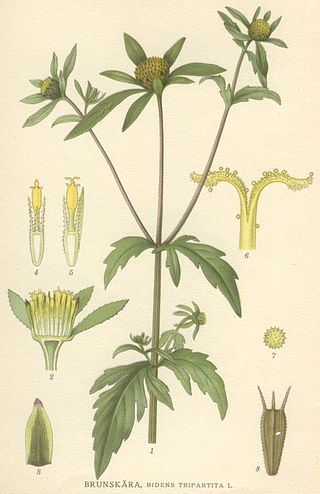
Bidens is a genus of flowering plants in the aster family, Asteraceae. The genus include roughly 230 species which are distributed worldwide. Despite their global distribution, the systematics and taxonomy of the genus has been described as complicated and unorganized. The common names beggarticks, black jack, burr marigolds, cobbler's pegs, Spanish needles, stickseeds, tickseeds and tickseed sunflowers refer to the fruits of the plants, most of which are bristly and barbed. The generic name refers to the same character; Bidens comes from the Latin bis ("two") and dens ("tooth").
Located about 2300 miles (3680 km) from the nearest continental shore, the Hawaiian Islands are the most isolated group of islands on the planet. The plant and animal life of the Hawaiian archipelago is the result of early, very infrequent colonizations of arriving species and the slow evolution of those species—in isolation from the rest of the world's flora and fauna—over a period of at least 5 million years. As a consequence, Hawai'i is home to a large number of endemic species. The radiation of species described by Charles Darwin in the Galapagos Islands which was critical to the formulation of his theory of evolution is far exceeded in the more isolated Hawaiian Islands.

Argyroxiphium is a small genus of plants in the family Asteraceae. Its members are known by the common names silversword or greensword due to their long, narrow leaves and the silvery hairs on some species. The silverswords belong to a larger radiation of over 50 species, including the physically different genera Dubautia and Wilkesia. This grouping is often referred to as the silversword alliance. Botanist P. H. Raven referred to this radiation as "the best example of adaptive radiation in plants".
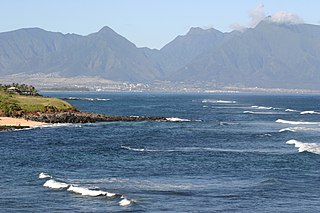
Puʻu Kukui is a mountain peak in Hawaiʻi. It is the highest peak of Mauna Kahalawai. The 5,788-foot (1,764 m) summit rises above the Puʻu Kukui Watershed Management Area, an 8,661-acre (35.05 km2) private nature preserve maintained by the Maui Land & Pineapple Company. The peak was formed by a volcano whose caldera eroded into what is now the Iao Valley.

The Maui parrotbill or kiwikiu is a species of Hawaiian honeycreeper endemic to the island of Maui in Hawaii. It can only be found in 50 square kilometres (19 sq mi) of mesic and wet forests at 1,200–2,150 metres (3,940–7,050 ft) on the windward slopes of Haleakalā. This species is critically endangered, with an estimated population in 2016 of 250-540 individuals, but more recent estimates of less than 150 individuals. Fossil evidence indicates that the bird could at one time be seen in dry forests at elevations as low as 200–300 metres (660–980 ft), as well as on the island of Molokaʻi.
Argyroxiphium virescens was a species of flowering plant in the family Asteraceae that was last seen in 1945. It was found only in the Hawaiian Islands where it was endemic to the eastern part of Maui. Its natural habitats were subtropical or tropical moist montane forests and subtropical or tropical high-altitude shrubland. It is officially declared extinct, but in 1989 plants were discovered that appear to be hybrids between it and the Haleakalā silversword. This hybrid is known as the Pu'u 'Alaea greensword.

Phyllostegia is a genus of flowering plant in the mint family, Lamiaceae, first described in 1840. It is native to certain islands in the Pacific. Phyllostegia glabra var. lanaiensis, became extinct before 2021 and was delisted from the Endangered Species Act based on extinction.
- Phyllostegia ambigua(A.Gray) Hillebr - Hawaii Big Island, Maui
- Phyllostegia bracteataSherff - Maui
- Phyllostegia brevidensA.Gray - Hawaii Big Island, Maui
- Phyllostegia electraC.N.Forbes - Kauai
- Phyllostegia floribundaBenth - Hawaii Big Island
- Phyllostegia glabra (Gaudich.) Benth. - Hawaiian Islands
- Phyllostegia grandiflora(Gaudich.) Benth - Oahu
- Phyllostegia haliakalaeWawra - Maui, Molokai
- Phyllostegia helleriSherff - Wai'alae Valley of Kauai
- †Phyllostegia hillebrandiiH.Mann ex Hillebr - Maui but extinct
- Phyllostegia hirsutaBenth. - Oahu
- Phyllostegia hispidaHillebr. - Molokai
- Phyllostegia kaalaensisH.St.John - Oahu
- Phyllostegia kahiliensisH.St.John - Kauai
- Phyllostegia knudseniiHillebr. - Kauai
- Phyllostegia macrophylla(Gaudich.) Benth. - Hawaii Big Island, Maui
- Phyllostegia manniiSherff - Molokai, Maui
- Phyllostegia micranthaH.St.John - Oahu
- Phyllostegia mollisBenth. - Hawaiian Islands
- Phyllostegia parvifloraBenth. - Hawaiian Islands
- Phyllostegia pilosaH.St.John - Hawaiian Islands
- Phyllostegia racemosaBenth. - Hawaiian Islands
- Phyllostegia renovansW.L.Wagner - Kauai
- †Phyllostegia rockiiSherff - Maui but extinct
- Phyllostegia stachyoidesA.Gray - Hawaiian Islands
- †Phyllostegia tahitensisNadeaud - Tahiti but extinct
- Phyllostegia tongaensisH.St.John - Tonga
- †Phyllostegia variabilisBitter - Midway Islands but extinct
- Phyllostegia velutina(Sherff) H.St.John - Hawaii Big Island
- Phyllostegia vestitaBenth. - Hawaii Big Island
- Phyllostegia waimeaeWawra - Kauai
- Phyllostegia warshaueriH.St.John - Hawaii Big Island
- Phyllostegia wawranaSherff - Kauai
- Phyllostegia × yamaguchiiHosaka & O.Deg. - Oahu (P. glabra × P. hirsuta)

Ochrosia is a genus of flowering plants, first described in 1789. It is in the family Apocynaceae, native to Southeast Asia, Australia, and various islands of the Indian and Pacific Oceans.
- Ochrosia ackeringae(Teijsm. & Binn.) Miq. – Indonesia, Philippines, Papuasia, Christmas Island
- Ochrosia acuminataTrimen ex Valeton – Sulawesi
- Ochrosia alyxioidesGuillaumin – Vanuatu
- Ochrosia apoensisElmer – Luzon, Mindanao
- Ochrosia balansae(Guillaumin) Baill. ex Guillaumin – New Caledonia
- Ochrosia basistaminaHendrian – Sulawesi
- Ochrosia bodenheimarumGuillaumin – Vallée de la Toutouta in New Caledonia
- Ochrosia borbonicaJ.F.Gmel. – Mauritius + Réunion; naturalized in Guangdong
- Ochrosia brevitubaBoiteau – New Caledonia
- Ochrosia brownii(Fosberg & Sachet) Lorence & Butaud – Nuku Hiva in Marquesas
- Ochrosia citrodoraK.Schum. & Lauterb. – New Guinea
- Ochrosia coccinea(Teijsm. & Binn.) Miq. – Maluku, Sulawesi, New Guinea, Solomon Islands; naturalized in Guangdong
- Ochrosia comptaK.Schum., Hōlei – Hawaii
- Ochrosia ellipticaLabill. – Lord Howe Island, Queensland, New Caledonia, Vanuatu, Nauru; naturalized in Guangdong + Taiwan
- Ochrosia fatuhivensisFosberg & Sachet – Fatu Hiva in Marquesas but extinct
- Ochrosia ficifolia(S.Moore) Markgr. – New Guinea
- Ochrosia glomerata(Blume) F.Muell. – Borneo, Sulawesi, Philippines, Maluku, New Guinea, Solomon Islands
- Ochrosia grandifloraBoit. – New Caledonia
- Ochrosia haleakalaeH.St.John, Hōlei – Maui + island of Hawaiʻi in Hawaiian Islands
- Ochrosia hexandraKoidz. – Kazan-retto
- Ochrosia inventorumL.Allorge – New Caledonia
- Ochrosia iwasakiana(Koidz.) Koidz. ex Masam.
- Ochrosia kauaiensisH.St.John, Hōlei – Kauaʻi in Hawaiian Islands
- †Ochrosia kilaueaensisH.St.John, Hōlei – island of Hawaiʻi in Hawaiian Islands, but extinct
- Ochrosia kilneriF.Muell. – Queensland
- Ochrosia lifuanaGuillaumin – Loyalty Islands + Isle of Pines in New Caledonia
- Ochrosia mariannensisA.DC. – Mariana Islands
- Ochrosia mianaBaill. ex Guillaumin – New Caledonia
- Ochrosia minima(Markgr.) Fosberg & Boiteau – Queensland, Papua New Guinea
- Ochrosia moorei(F.Muell.) F.Muell. ex Benth. – Queensland, New South Wales
- Ochrosia mulsantiiMontrouz. – New Caledonia
- Ochrosia nakaiana(Koidz.) Koidz. ex H.Hara – Ogasawara-shoto
- Ochrosia newellianaF.M.Bailey – Queensland
- Ochrosia novocaledonicaDäniker – New Caledonia
- Ochrosia oppositifolia(Lam.) K.Schum. – Seychelles, Chagos Islands, Sri Lanka, Maldive Islands, Andaman & Nicobar Islands, Thailand, Vietnam, W Malaysia, Indonesia, Papuasia, Samoa, Tonga, Tuvalu, Vanuatu, Wallis & Futuna, French Polynesia, Line Islands, Micronesia
- Ochrosia poweriF.M.Bailey – Queensland, New South Wales
- Ochrosia sciadophyllaMarkgr – Bismarck Archipelago, Solomon Islands
- Ochrosia sevenetiiBoiteau – New Guinea
- Ochrosia silvaticaDäniker – New Caledonia
- Ochrosia solomonensis(Merr. & L.M.Perry) Fosberg & Boiteau – Solomon Islands
- Ochrosia syncarpaMarkgr. – Bali, Lombok, Timor, Flores
- Ochrosia tahitensisLaness. ex Pichon – Tahiti
- Ochrosia tenimberensisMarkgr. – Tanimbar Islands
- Ochrosia nukuhivensisFosberg & Sachet = Rauvolfia nukuhivensis(Fosberg & Sachet) Lorence & Butaud
- Ochrosia sandwicensisA.DC. = Rauvolfia sandwicensisA.DC.
- Ochrosia tuberculata(Vahl) Pichon = Rauvolfia sandwicensisA.DC.
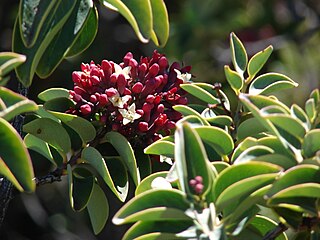
Santalum haleakalae, known as Haleakala sandalwood or ʻIliahi in Hawaiian, is a species of flowering tree in the sandalwood family, that is endemic to the islands of Maui, Lanai, and Molokai in the Hawaiian Islands, part of the United States. It grows in subalpine shrublands at elevations of 1,900 to 2,700 m, especially on the slopes of Haleakalā.

Santalum freycinetianum, the forest sandalwood, Freycinet sandalwood, or ʻIliahi, is a species of flowering tree in the European mistletoe family, Santalaceae, that is endemic to the Hawaiian Islands. Its binomial name commemorates Henri Louis Claude de Saulces de Freycinet, a 19th-century French explorer. ʻIliahi inhabits dry, coastal mesic, mixed mesic, and wet forests on Oʻahu, Kauaʻi, Lānaʻi, Maui, and Molokaʻi at elevations of 250–950 m (820–3,120 ft). It grows in areas that receive 500–3,800 mm (20–150 in) of annual rainfall. Like other members of its genus, ʻiliahi is a root hemi-parasite, deriving some of its nutrients from the host plant; common hosts include koa, koaiʻa, and ʻaʻaliʻi.

Asplenium montanum, commonly known as the mountain spleenwort, is a small fern endemic to the eastern United States. It is found primarily in the Appalachian Mountains from Vermont to Alabama, with a few isolated populations in the Ozarks and in the Ohio Valley. It grows in small crevices in sandstone cliffs with highly acid soil, where it is usually the only vascular plant occupying that ecological niche. It can be recognized by its tufts of dark blue-green, highly divided leaves. The species was first described in 1810 by the botanist Carl Ludwig Willdenow. No subspecies have been described, although a discolored and highly dissected form was reported from the Shawangunk Mountains in 1974. Asplenium montanum is a diploid member of the "Appalachian Asplenium complex," a group of spleenwort species and hybrids which have formed by reticulate evolution. Members of the complex descended from A. montanum are among the few other vascular plants that can tolerate its typical habitat.

Athyrium angustum, the northern lady fern, is a fern native to northeastern North America. It was long included in the superspecies Athyrium filix-femina, but is now largely recognized as a distinct species.

Asplenium ruta-muraria is a species of fern commonly known as wall-rue. It is a very small epipetric species, growing exclusively on limestone and other calcareous rocks. Its fronds are bluish-green and are heavily sub-divided, becoming up to 12 cm in length.

Hyposmocoma haleakalae is a species of moth of the family Cosmopterigidae. It was first described by Arthur Gardiner Butler in 1881. It is endemic to the Hawaiian island of Maui. The type locality is Haleakalā, where it was collected at an elevation of 4,000 feet (1,200 m).

Diplazium molokaiense is a rare species of fern known by the common name Molokai twinsorus fern. It is endemic to Hawaii, where it is one of the rarest ferns. It has historically been found on the islands of Kauai, Oahu, Lanai, Molokai, and Maui, but it is thought to have been extirpated from four of them and today can be found only on Maui where fewer than 70 individual plants remain. The fern was federally listed as an endangered species of the United States in 1994.

Doryopteris angelica is a rare fern species, known by the common name Kauai digit fern. It is endemic to Hawaii where only small populations are known.

Asplenium adiantum-nigrum is a common species of fern known by the common name black spleenwort. It is found mostly in Africa, Europe, and Eurasia, but is also native to a few locales in Mexico and the United States.
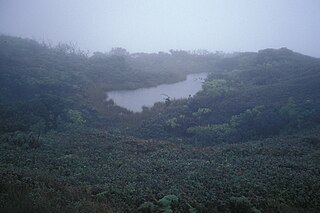
Violet Lake, is a small high-elevation lake located at 5,020 ft (1,530 m) above sea level on Mauna Kahalawai, situated in the western part of the island of Maui. It is located in the boggy slopes near the ʻEke Crater and Puʻu Kukui, the highest peak of the West Maui Mountains. It is approximately 10 ft × 20 ft in size.

Cyrtandra heinrichii, known as ha'iwale or lava cyrtandra, is a perennial flowering plant in the family Gesneriaceae. It is found on the Hawaiian island of Kauai.
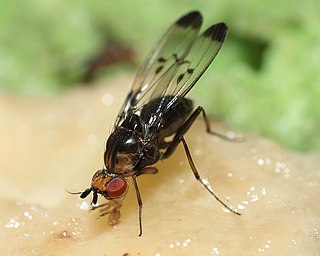
The Hawaiian Drosophilidae are a lineage of flies within the genus Drosophila. This monophyletic clade includes all of the endemic Hawaiian Drosophila and all members of the genus Scaptomyza, which contains both Hawaiian and non-Hawaiian species. The Hawaiian Drosophilidae are descended from a common ancestor estimated to have lived 25 million years ago. Species of Hawaiian Drosophilidae flies have been studied as models of speciation and behavioral evolution. Along with other members of the native Hawaiian ecosystem, the conservations status of many species of Hawaiian Drosophilidae is threatened by habitat loss and introduced predators, among other factors.

















